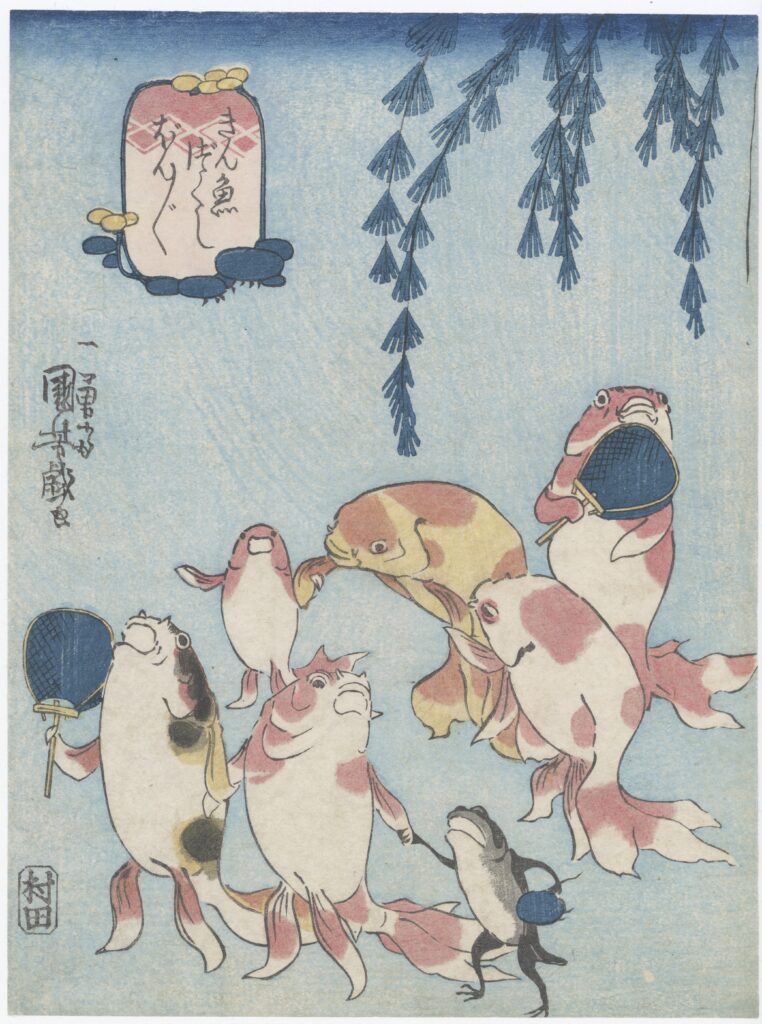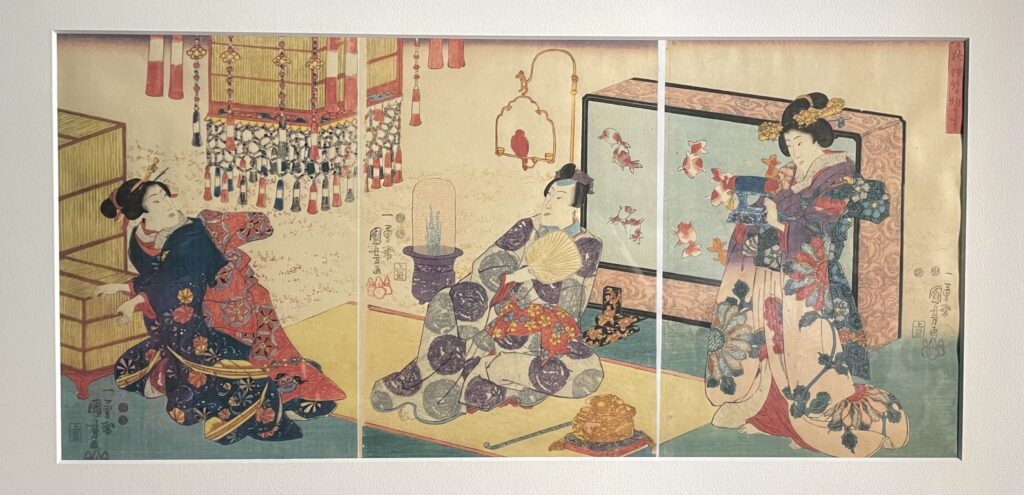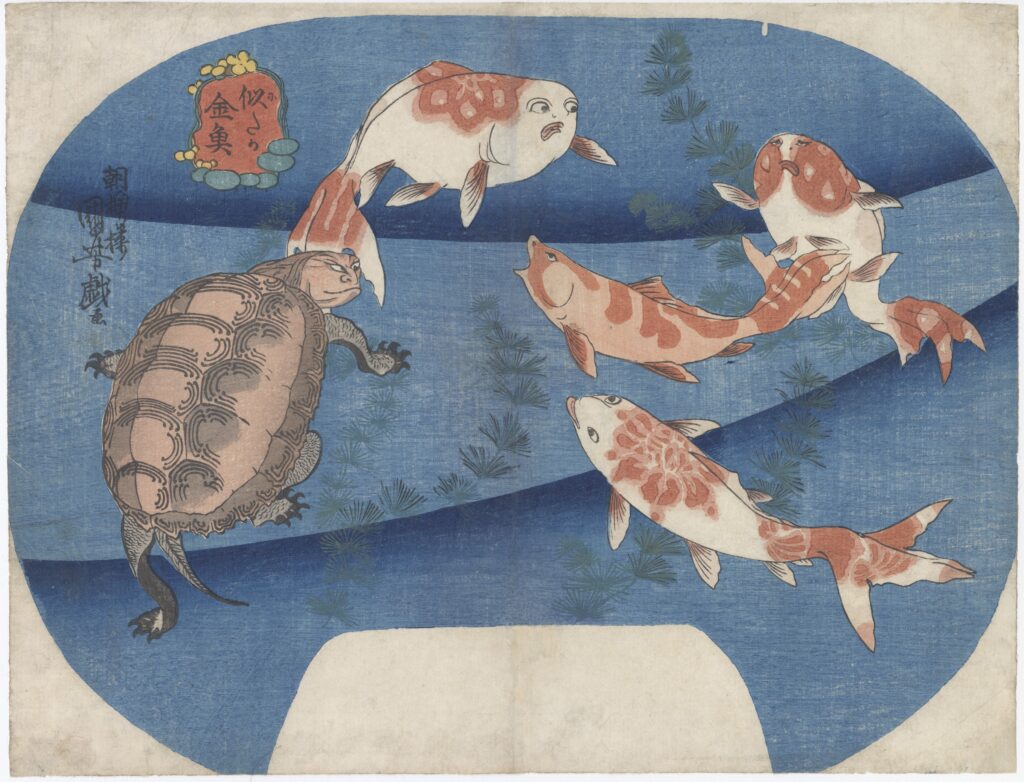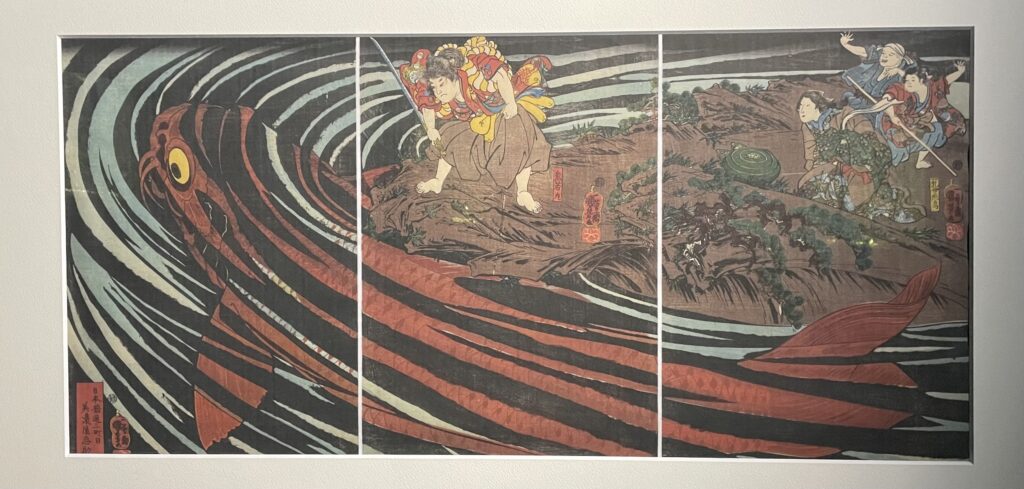浮世絵 金魚と鯉
ぼんぼん
Singing ‘bonbon’ song

擬人化金魚が可愛い、国芳作品のなかでも人気の“金魚づくし”シリーズ。本作は、子どもたちが手をつなぎながら“ぼんぼん歌”を歌って歩くお盆の季節の遊びが描かれています。金魚たちが持つ扇子はすくい網になっていたり、水中の藻は柳に見立てられていたりと、細かいところまで金魚が擬人化された世界が面白く表現されています。
Kuniyoshi's popular series “Goldfish Miscellany” is a cute anthropomorphic goldfish. This work depicts children walking hand in hand while singing the “Bonbon Song” during the Obon period, and the world of anthropomorphic goldfish is interestingly expressed in every detail. The fan held by the goldfish becomes a net, and the algae in the water resembles a willow tree.
.
いかだのり
Raftsmen

いかだに乗る金魚と船に乗る蛙がすれ違い、何か会話をしているようです。江戸当時では、最も粋な職業とされていた“船頭”を擬人化金魚で描いた作品です。ひれをまくり上げた姿からはまさに“船頭”のカッコ良さが表現されています。 遠くの鳥や、いかだが進む静かな水の流れが趣のある作品になっています。
Series “Goldfish Miscellany”—Raftsmen. A goldfish on a raft and a frog on a boat pass each other and seem to be having a conversation. This is a work depicting a "boatman", which was considered the most stylish profession in the Edo period, as an anthropomorphic goldfish. The figure with its fins rolled up truly represents the coolness of a "boatman." The birds in the distance and the calm flow of water along which the raft moves make for an atmospheric piece.
.
今様伊勢物がたり
Imayo Ise Monogatari

伊勢物がたりとは、平安時代初期に実在した貴族である在原業平を主人公とした和歌にまつわる短編歌物語集で、主人公の恋愛を中心とする物語。本作は、優美で洗練された文化感じる物語を江戸時代当時に“今様”で表現した作品です。そこに存在する立派な水槽のなかを泳ぐのは金魚。江戸時代では貴族にも庶民にも金魚が親しまれていた、ということを垣間見ることができます。
“Ise Monogatari” is a short story about waka poems, featuring Ariwara Narihira, an aristocrat from the early Heian period, as the main character, and the story revolves around the main character's love life. This is a work that expresses that story in a modern way during the Edo period.There are goldfish swimming in a nice aquarium. You can get a glimpse of how goldfish were loved by everyone from the nobility to the common people during the Edo period.
.
金魚にめだか
Goldfish and Killifish

水中に浮かぶ何かの破片に集まる金魚とめだかの様子が描かれた本作。水面に落ちた花びらに魚たちが集まってくるところを描く、掛軸の花鳥画に通ずる風情をみることができます。金魚とめだかの体のうねりで画面全体に動きが生まれる構図で、水の中の趣ある空間が美しい作品です。
This work depicts goldfish and medaka fish gathering around some debris floating in the water. You can see the atmosphere similar to the flower and bird paintings on hanging scrolls, which depict fish gathering around flower petals that have fallen on the water surface. The composition is such that the undulations of the bodies of the goldfish and medaka create movement throughout the screen, and the atmospheric underwater space is beautiful.
.
似たか金魚
Look-Alike Goldfish with Actors’ Expressions

金魚や亀の姿で役者似顔が描かれた作品。それぞれの体の模様から描かれた役者を想像することができます。背中に八重桔梗が描かれている画面上の金魚は、二代目市川九蔵。江戸時代に着物の柄として流行した芝翫縞(しかんじま)が甲羅に描かれる亀は、四代目中村歌右衛門と考えられています。役者絵に可愛らしさとユーモアが交わる国芳らしい作品です。
This work features portraits of actors in the form of goldfish and turtles. You can imagine the actors depicted from the patterns on each body. The goldfish on the screen with a double bellflower drawn on its back is the second generation Kuzo Ichikawa. The turtle whose shell is decorated with shikanjima stripes, which were popular as kimono patterns during the Edo period, is believed to be the fourth generation of Utaemon Nakamura. This is a work typical of Kuniyoshi, where cuteness and humor intertwine with the actor paintings.
.
坂田怪童丸
Sakata Kaidomaru

金太郎の名で知られる怪童丸。その姿は江戸時代、多くの浮世絵に描かれました。その怪力で鬼退治などでも活躍する怪童丸が、自身よりも大きい鯉をやすやすと持ち上げている場面を描いた本作。出世して活躍する怪童丸と、滝を登り龍になるという鯉の組み合わせは、男児の成長を願う人々の想いをあらわした、とも言われています。怪童丸の表情や肌の色、また鯉の勢いや弾ける水の表現など、生気あふれるダイナミックな画面を構成しています。
Kaidomaru is known as Kintaro. Its appearance was depicted in many ukiyo-e paintings during the Edo period. This work depicts a scene in which Kaidomaru, whose superhuman strength is used to exterminate demons, effortlessly lifts a carp larger than himself. It is said that the combination of Kaidomaru, who is successful in his career, and the carp, which climbs a waterfall and becomes a dragon, represents the people's hopes for the growth of boys. The expression of Kaidomaru's expression and skin color, as well as the force of the carp and the splashing of the water, create a lively and dynamic screen.
.
西塔鬼若丸
鬼若丸の鯉退治
Oniwakamaru Fighting with a Huge Carp


歴史に名を刻んだ英雄や武将、またその場面を描いた“武者絵”。美人画や役者絵、風景画と並ぶ幕末浮世絵の人気ジャンルで、そのパイオニアとして国芳は重要な位置を占めています。
“武者絵の国芳”とよばれる国芳が好んで描いた題材「鬼若丸の鯉退治」の作品を8作品展示します。鬼若丸よりも一回り大きく描かれる鯉(なかには一回りどころか何倍にも大きく描かれた鯉も)と、それに立ち向かうヒーロー・鬼若丸がダイナミックに表現されています。同じ場面を描く作品群も、鬼若丸の構えや鯉の動き、水しぶきなど、細かいところまでそれぞれの見応えがあります。国芳が研究し続けた“カッコイイ”戦いの場面、その躍動感をお楽しみください。
”Musha-e,” which depict historical heroes and military commanders and their scenes, was a popular genre of ukiyo-e at the end of the Edo period, along with bijinga, actor-e, and landscape paintings. Kuniyoshi occupies an important position as a pioneer. Eight of Kuniyoshi's beloved paintings,”Oniwakamaru Fighting with a Huge Carp,” will be on display.The carp is drawn one size larger than Oniwakamaru (sometimes the carp is drawn not only one size but many times larger), dynamically expressing the main character Oniwakamaru who confronts him. Even though the works depict the same scene, the details such as Oniwakamaru's standing posture, the movement of the carp, and the splashing of water are all worth seeing. Please enjoy the dynamism of the "cool" battle scenes that Kuniyoshi has continued to research.